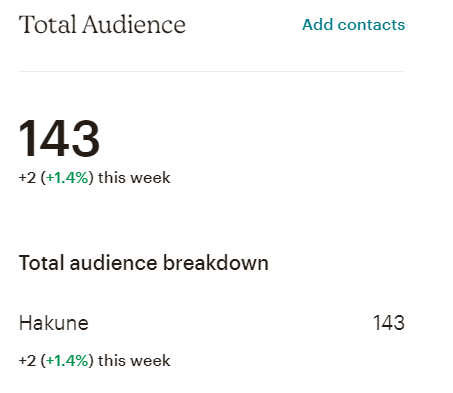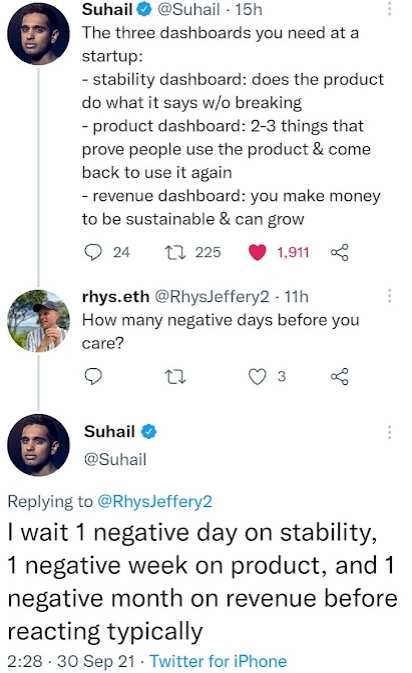One Key Metric: A Trick Many Of The Worlds Best Entrepreneurs Use
We’re data-rich.
Software has made it possible for us (small business owners) to track an increasing amount of metrics.
The problem is most of the time, most of that data is useless.
I’ve made the mistake of drowning myself in useless data more times than I can count. The result is always confusion, not clarity.
If you think about it, we should only care about the information we can use to make decisions. Everything else is surplus to requirements.
What I’m talking about here is your key business metrics. Everything else should be known as vanity metrics.
There are many benefits to finding your key business metrics;
• You’ll know whether each action you take contributes to or takes away from your business.
• You’ll save yourself a lot of time by no longer paying attention to useless information.
• You’ll be able to communicate to your team what they should care about.
• You can tie compensation to these numbers, so your staff’s incentives are aligned with your companies.
• Planning is easier. Because you know the metrics, you need to improve to succeed.
There are two frameworks I’ve used to find the right metrics for my businesses which we’ll look at here.
The One Key Metric
I borrowed this one from watching the best entrepreneurs of our generation.
They’re all insanely good at figuring out the one key indicator that drives everything else in their companies.
They use 1st principles thinking to dial in on the one key metric (OKM) that removes all the noise from decision making and provides one clear & true signal.
Suhail (Mixpanel & Mighty) calls this the metric you can bet your company on. In other words, you can base all company decisions on this number. Everything you do should be trying to improve this number.
Take this blog, for example; our one key metric is weekly email subscribers. I’ve lost countless hours worrying about page views, bounce rate, pages per session, organic traffic, and so on. The only number that truly matters is how many people signed up for our newsletter.

Every decision we make has to answer this question.
Will this action improve our one key metric, weekly email subscribers?
If yes, great. If unsure, meh. If no, don’t do.
If we publish good content, sure bounce rate, page views etc., will improve, but ultimately, the clearest signal that our content is good is when a reader signs up for our newsletter. Small percentage movements in those other numbers don’t matter.
At my gym, the one key metric is the average monthly revenue per member. We’re always trying to improve this number.

If we improve customer service, members will stay longer and spend more, increasing ARPM. If we stock our shelves with better products, members will buy more, and ARPM increases. If we upgrade our equipment, members will stay longer and even upgrade their memberships, increasing ARPM.
If you pay close attention to Elon Musk, he often talks about his one key metric. He never defines it as that but often says ‘this is what we’re focusing on’ or ‘achieving this will make everything else possible.
When talking about his ‘Boring Company,’ he speaks of the ‘boring cost per mile to create tunnels. When talking about Space X, Elon regularly mentions ‘payload cost per kg’.
‘Mr. Beast’, the world’s most-watched YouTuber, says there’s only one number that matters, retention, i.e. the percentage of people who watch his videos to completion.
How To Find Your One Key Metric
Every startup, small business, or large company has one.
If you find yours, as you might imagine, your life as an operator and decision-maker becomes noticeably more manageable.
To find that one key metric amongst all the other BS we get fed. You need to dive into the foundations of your business. Know what you’re trying to achieve and what actions or outputs will make that possible.
Question 1: What are you trying to achieve?
(A) At this blog, we want as many people as possible to read our content, and we think the best way to do that is by building an audience. We’re not skilled at videography, graphic design etc., so we figured an email audience makes sense.
(B) At the gym, me and my business partner want to earn enough money to live a schedule free, healthy lifestyle. At the moment, we think that’s an annual income of $90,000, with the gym fully managed.
Question 2: What needs to happen to make this possible?
(A) We need to get more email subscribers
(B) We need to generate enough revenue and profit to make this possible
Question 3: What activity or outcome makes this possible, and we can bet the company on it?
(A) Every time we get a new email subscriber, we know we’re heading in the right direction. So we want to track new email subscribers. We can bet the house on increasing new email subscribers.
(B) We have limited space at our gym, so we need to maximise the revenue and profit we can generate from each member. Profit per member is tough for us to track, but revenue per member is straightforward. We can bet the company on increasing revenue per member.
While these numbers are easy to dial in on now, it took me years to get here. So I get it if this isn’t clear to you.
In that case, I suggest going broader with the sitting at the beach test. Over time, the one key metric will reveal itself to you.
The Sitting At The Beach Test

The premise is simple.
If you’re on holiday, sitting at a beach, miles away from your business and had to choose a couple of key indicators that will tell you all you need to know about your company for peace of mind. What are those numbers?
With these numbers in hand, and only them. No emails or quick updates from your team. No checking your social media, nothing.
With one quick check, you should be able to tell if your ship is sinking or on course.
I’ve found somewhere between 5 – 7 is the sweet spot. Less is better, and 7 is max.
Suhail, of Mighty, uses just 3.
At my gym, for example, we use 5.

If you found these frameworks helpful, you might be interested in joining our weekly newsletter. We share the frameworks, methods and mental models we’ve used to build multiple 7 figure businesses.


One comment
Pingbacks and Tracebacks
[…] say you don’t need to monitor work if you set good KPIs. But what are we meant to do? Set a KPI for every task we delegate. And some work just isn’t […]